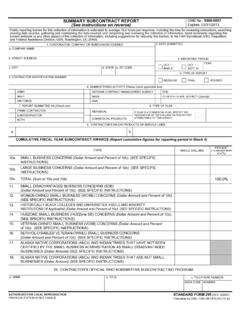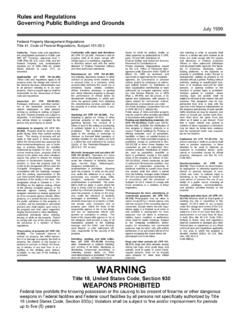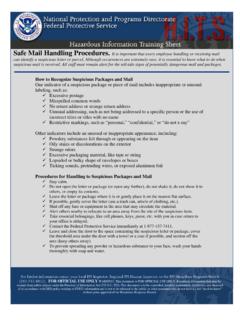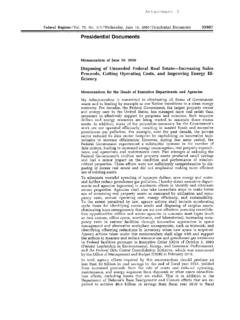Transcription of Chapter V BUDGET EXECUTION - United States Department of ...
1 Chapter V BUDGET EXECUTION . Page Number Section 1 Summary of Process V(1) - 1. A. General V(1) - 1. B. Legal Framework V(1) - 1. C. Steps in BUDGET EXECUTION V(1) - 2. Plans V(1) - 2. and Reapportionments V(1) - 2. on BUDGET EXECUTION V(1) - 3. Requirements V(1) - 3. Section 2 Roles and Responsibilities V(2) - 1. A. Government-wide Roles V(2) - 1. B. Department of Commerce V(2) - 1. C. Operating Units V(2) - 2. 1. Heads of Operating Units V(2) - 2. Unit BUDGET Officers V(2) - 3. Officer V(2) - 3. Section 3 Apportionments V(3) - 1. A. General V(3) - 1. B. Legal Basis for Apportionment V(3) - 1. C. Apportionable Accounts V(3) - 1. D. annual List of accounts V(3) - 2. E. Deficiency or Supplemental Apportionments V(3) - 2.
2 F. Amounts Proposed for Rescission or Deferral V(3) - 2. G. Relationship tp Financial Plans V(3) - 3. H. Schedule V(3) - 3. V-Outline I. Standard Apportionment Procedures V(3) - 3. 1. Initial Apportionments V(3) - 3. 2. Automatic Apportionments V(3) - 4. 3. Reapportionments V(3) - 5. J. Allocation of Apportioned Amounts V(3) - 5. Section 4 Reports on BUDGET EXECUTION V(4) - 1. A. General V(4) - 1. B. Reporting Procedures V(4) - 1. C. Coverage V(4) - 1. D. Verification of Data V(4) - 2. Section 5 Rescissions and Deferrals V(5) - 1. A. General V(5) - 1. B. Rescissions V(5) - 1. C. Deferrals V(5) - 1. D. Reserves V(5) - 1. E. Cases Requiring Special Messages V(5) - 2. F. Contents of Special and Supplementary Messages and V(5) - 2.
3 Reports G. Reviewing Deferrals V(5) - 2. Section 6 Monitoring Federal Outlays V(6) - 1. A. General V(6) - 1. B. Reporting Requirements V(6) - 1. C. Timing of Submissions V(6) - 1. 1. October 1st - Initial Plan V(6) - 1. 2. One week after BUDGET Transmittal to Congress - lst V(6) - 2. Update V-Outline 3. April - 2nd Update V(6) - 2. 4. July - Final Update V(6) - 2. Section 7 Reprogrammings V(7) - 1. A. Procedure for Reprogramming notification Requests V(7) - 1. B. Criteria for Reprogramming Notifications V(7) - 1. C. Criteria for Transfer notification V(7) - 3. Section 8 Financial Plans and Reports V(8) - 1. A. General Requirements V(8) - 1. B. Detailed Internal Financial and Staffing Plans V(8) - 1. C. Summary Plans and Reports sent to the Department V(8) - 2.
4 D. Specific Information Required for Plans V(8) - 3. 1. Information Required for all Operating Plans V(8) - 3. a. Financial Plans V(8) - 3. b. Staffing Plans V(8) - 4. E. Requirements Specific to operating units V(8) - 4. F. Explanation of Variances V(8) - 4. Section 9 Congressional Directives V(9) - 1. A. General V(9) - 1. B. Departmental Compliance Policy V(9) - 1. C. Information Included in Response V(9) - 2. D. Format V(9) - 2. V-Outline Chapter V BUDGET EXECUTION . Section 1 - Summary of Process A. General BUDGET EXECUTION is the process by which the financial resources made available to an agency are directed and controlled toward achieving the purposes and objects for which budgets were approved. The process involves compliance with both legal and administrative requirements.
5 OMB Circular A-11 provides detailed instructions on all aspects of BUDGET EXECUTION . The information presented in this Handbook is designed to supplement and clarify the instructions contained in Circular A-11. The General Accounting Office publication, Principles of Federal Appropriations Law, (July 1991) is a comprehensive reference regarding the basic principles of appropriation law. It discusses the statutes and regulations governing appropriations matters and references significant decisions rendered by the Comptroller General and the courts. Each operating unit BUDGET office should have a copy of this document available for reference. Principles of Federal Appropriations Law discusses the use of budgetary resources in terms of availability as to purpose, time and amount.
6 According to this concept, the legality of an expenditure depends on three things: the purpose of the expenditure must be proper;. the obligation must occur within the time limits applicable to the appropriation; and the obligation must be within the amounts Congress has established. Proper BUDGET EXECUTION requires compliance with these three principles. The instructions contained in Circular A-11 and this Chapter of the Handbook, if properly followed, will assure that BUDGET EXECUTION in the Department of Commerce meets required standards. B. Legal Framework 31 1301 and 1341 provide the basic legal framework for BUDGET EXECUTION . The text of these sections are included in Chapter II, Section of this Handbook.
7 Section 1301 provides that "appropriations shall be applied only to the objects for which the appropriations were made." A single appropriation account may provide funds for numerous programs and activities, thus providing an agency considerable discretion in spending the money. Nevertheless, agency spending is usually guided by: the justifications presented to the Appropriations Committees; and the enacted appropriations bill and accompanying reports. (See Section 9 of this Chapter on V(1)-1. Congressional Directives). Section 1301 also States that an appropriation in a regular, annual appropriation law remains available only for that fiscal year unless the act "expressly provides that it is available after the fiscal year covered by the law in which it appears" or the appropriation is for rivers and harbors, lighthouses, public buildings or the pay of the Navy and Marine Corps.
8 Section 1341 prohibits obligation or expenditure in excess of the amount appropriated and the incurring of obligations in advance of appropriations, except as "authorized by law". C. Steps in BUDGET EXECUTION 1. Financial Plans The agency's financial plan is the first phase of BUDGET EXECUTION . The President's BUDGET is the framework of the initial financial plan and should be internally updated through the various phases of Congressional action leading to enactment. The Office of BUDGET requires that bureaus submit financial plans based on recommended Conference Committee action two weeks after Senate action on the appropriation bill is completed. Section 8 of this Chapter of the Handbook discusses requirements for financial plans submitted to the Office of BUDGET .
9 Per Section of OMB Circular A-11, financial plans must accompany all apportionment and reapportionment requests to OMB. 2. Apportionments and Reapportionments Except in a few cases as provided by law, funds contained in appropriations legislation and other funds, (including reimbursements, recoveries of prior year funds, and carryover funds). may not be obligated until they are apportioned. See Section 120 of Circular A-11 for additional information on exceptions. Apportionment requests prepared by agencies are not valid until OMB approves the apportionment. Usually, the signature of the appropriate OMB official constitutes approval. Exceptions are: a. emergencies involving the safety of human life or the protection of property for which OMB may provide telephone approval of apportionments under Section of OMB.
10 Circular A-11; and b. adjustments not requiring submission of a reapportionment request and which are considered to be "automatically apportioned" as provided under Section of the Circular. Agencies then allot the apportioned funds among their operating units or other administrative subdivisions. When the level of funds provided changes, (supplemental appropriations, extensions of continuing resolutions, enactment of full year appropriations, etc.), agencies must prepare reapportionment requests and receive OMB approval before the funds may be obligated. Section 3 of this Chapter of the Handbook and Part IV: Instructions on BUDGET EXECUTION of V(1)-2. Circular A-11 provide instructions for apportionments and reapportionments.














